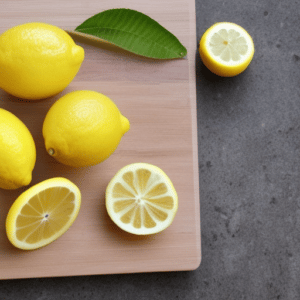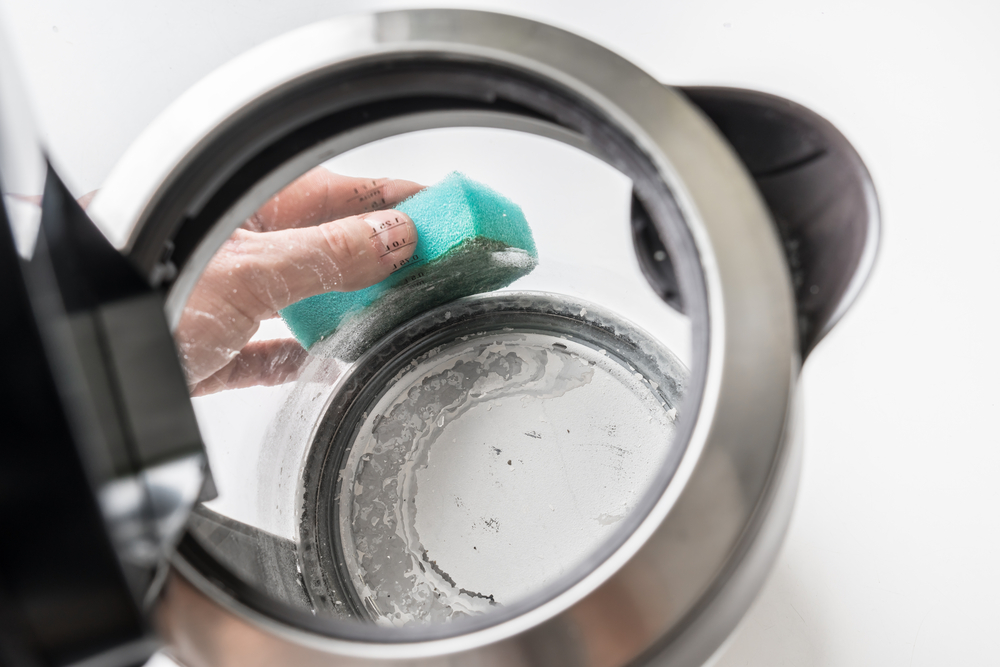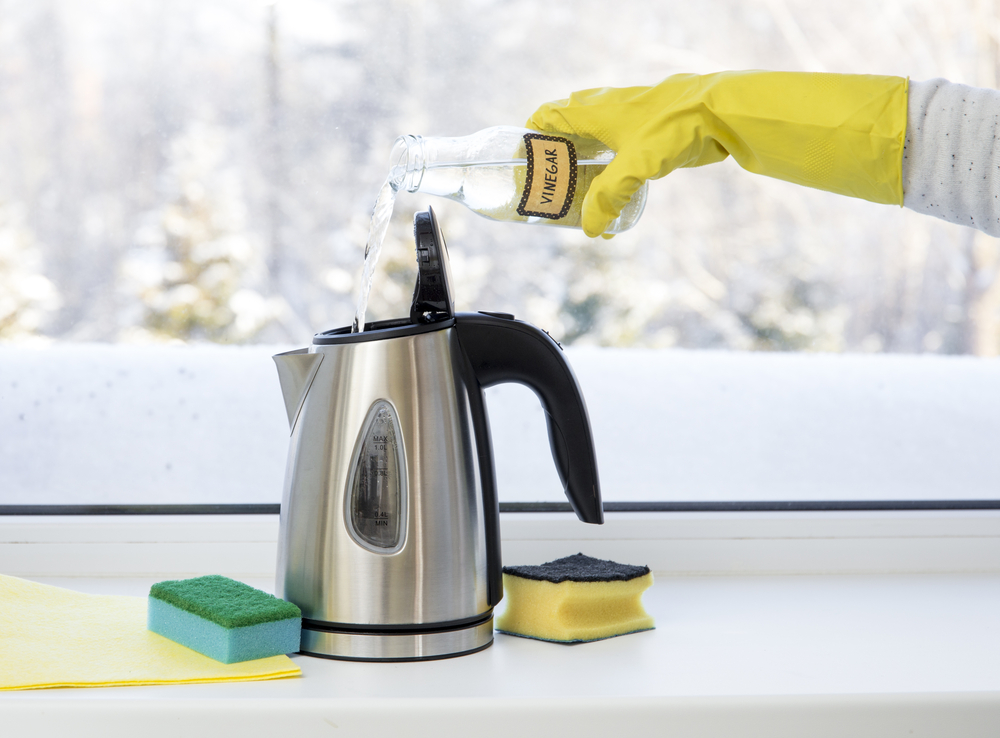Have you noticed that your kettle takes a bit longer to make tea than it did when it was brand new? You may have a limescale issue that affects your kettle’s performance. Besides that, limescale is a notorious culprit that could shorten the lifespan of your tea kettle.
Since the problem won’t go away on its own, there are a few things you can do to prevent limescale buildup in your kettle. Keep on reading if you want to discover how to descale a kettle at home.
What Is Limescale and What Causes It in Kettles?
Limescale is made up of calcium carbonate that looks like a white, chalky substance that resembles the deposits that are common in rocks and seashells. Even though the limescale is usually white, it could also be reddish-brown, pink or grey.
So how do the limescale deposits build up in most kettles? If you boil hard water in your electric kettle and it evaporates, hard minerals such as calcium and magnesium will build up and solidify to become limescale. The harder your water supply, the more likely you will have limescale build-up in your kettle.
How to Descale a Kettle in 4 Easy Methods
Now that you know what causes limescale in your kettle, you can easily remove it at home using acidic liquids. When descaling a kettle, you can follow the simple methods below.
Method 1: Lemon Juice

Lemon works like a charm to remove the limescale mineral deposits. This is because it contains citric acid with an average PH of between 2 to 3. Here is the process of how to descale a kettle with lemon juice.
- Fill up the kettle with equal parts of water and lemon juice.
- Let the mixture sit for half an hour.
- Boil the water and lemon juice mixture and let it sit again for half an hour.
- Pour it out and rinse the kettle.
Note: If you still notice limescale residue in your kettle’s heating element, you can repeat the process as many times as necessary but fill up the kettle with ¾ lemon juice and ¼ water mixture.
Method 2: White Vinegar
White vinegar is another brilliant way to descale your kettle because it’s also a mild acid with a PH of about 2.5. Here is the process of how to descale a kettle with vinegar.
- Pour equal parts of vinegar and water into your kettle.
- Let the water and white vinegar solution soak in the kettle for half an hour.
- Boil the kettle and let the mixture sit until it has completely cooled.
- Drain the vinegar and water solution and rinse the kettle with cold water.
- Pour fresh water into the kettle and boil it. After the water is hot, drain the kettle and rinse it with cold water. Repeat this step a couple of times until you get rid of the vinegar aftertaste in your water.
Note: If you still haven’t removed the limescale in your kettle, you can repeat steps 1 to 4 as many times as necessary.
Method 3: Baking Soda
Even though baking soda is not acidic like vinegar or lemon juice, you could also use it to remove limescale. Here is the process of how to descale a kettle with bicarbonate of soda.
- Mix a teaspoon of sodium bicarbonate for every half a litre of water. For instance, if your kettle can hold 2 litres of water, then you should add four teaspoons of baking soda.
- Boil the baking soda and water solution and let it soak for 30 minutes.
- Pour out the baking soda mixture. Rinse the interior of the kettle with fresh water.
Alternative Baking Soda Method
If you still haven’t removed the limescale using the steps we’ve prescribed above, you can try a different and more efficient method. This is what you should do.
- Add a tablespoon of baking soda to your kettle.
- Mix a few drops of white vinegar and baking soda to create a fizzing paste.
- Scoop the paste with a toothbrush and scrub the inside of your kettle until you’ve removed all the limescale left.
- Wash the kettle at least 2 or 3 times with water. If you boil water in the kettle and notice a weird taste, you should clean it as many times as necessary.
Method 4: Coca-cola
Coke contains phosphoric acid with a PH level of between 2.3 to 2.8. This makes it perfect not just for removing limescale deposits but also for eliminating rust. So here is how you do it:
- Fill the kettle with coca-cola and let it boil.
- Allow the coca-cola to cool and soak in the kettle for at least 45 minutes.
- Pour out the coke and drench your kettle with fresh water.
- Boil fresh water in your kettle and drain it. Thoroughly clean and rinse your kettle again.
How Often Should You Descale a Kettle?
If you live in hard water areas, you should descale your kettle at least once every month. At most, we don’t recommend going more than two months without descaling your kettle. Remember, the longer you stay without cleaning kettle limescale, the more difficult it will be to get rid of the water stains.
However, if you have soft water in your home, you can stay longer without having a limescale problem in your kettle.
How Do You Prevent Limescale?
There are several ways to prevent limescale build-up and to keep your kettle clean from limescale residues.
Install a Water Filter
The best thing you can do to prevent limescale problems in your kettle is to install a water filter that removes hard minerals from your water. Nevertheless, it’s possible to use a water filter and still see limescale in your kettle, although the limescale will collect much faster if you’re using hard water.
Use Descaler Balls
You could also put descaler balls inside your kettle to prevent limescale build-ups. The descaler balls are designed to regularly trap solidified hard minerals that cause limescale in your kettle. However, they’re not 100 per cent efficient.
Drain the Kettle After Every Use
Make sure you drain the water in your kettle after using it. The limescale will accumulate faster if you leave water inside your kettle overnight. Come to think of it, your tea would taste better if boiled with fresh water.
Add Vinegar or Lemon Juice
If you pour a few drops of vinegar or lemon juice into your kettle every time you’re done using it, you will have less limescale to worry about. Don’t forget to rinse the kettle’s interior and wipe the outside with a damp cloth immersed in soapy water.
Why Should You Remove Limescale?

Even though limescale is not dangerous for your health, it could make you replace your kettle earlier than usual. Too much limescale could clog your heating elements and reduce your kettle boiling time if that doesn’t bother you. This means you will probably spend more on the electricity bill.
What’s more, the limescale could make your tea or coffee taste salty; just hope you don’t accidentally crunch into a piece of limescale floating while drinking your morning tea.
Keep Your Kettle Limescale-Free
Now that you know how to descale a kettle without chemicals, you can be assured that your kettle will last longer. So, what is the best way to descale a kettle? As long as you get the job done, it doesn’t matter whether you use vinegar, lemon juice, baking soda or coca-cola to descale your kettle.
Otherwise, you should make sure you clean your kettle regularly using vinegar or lemon water to prevent limescale build-up before it becomes a problem.

